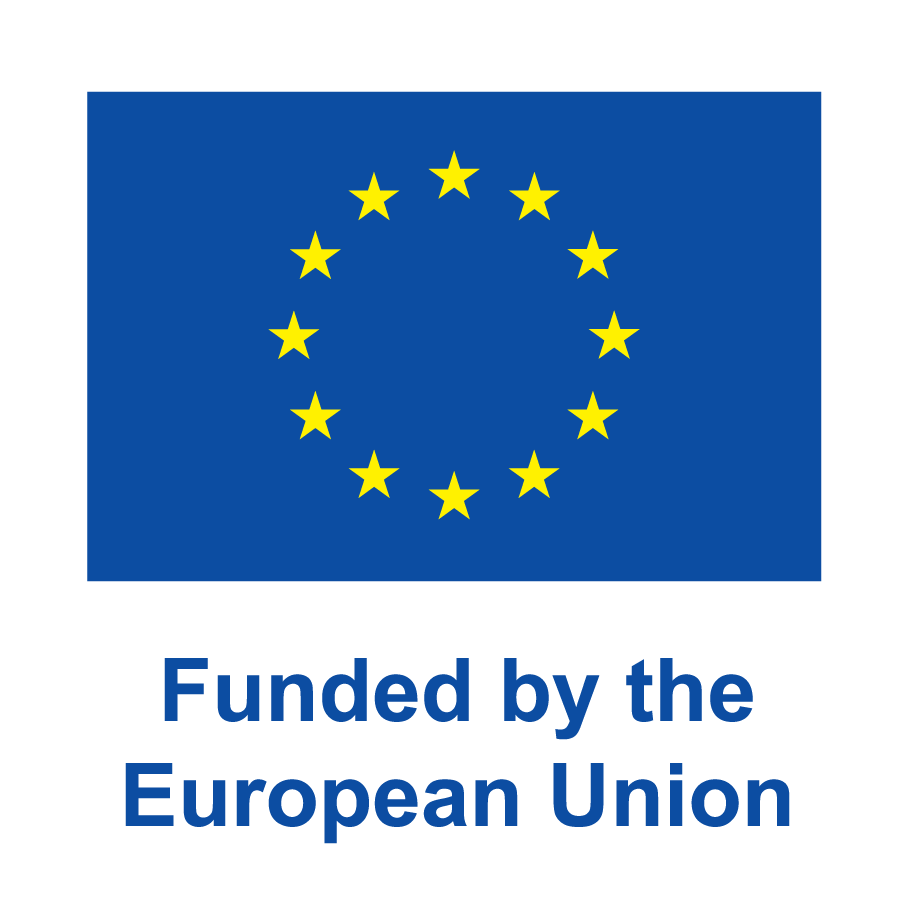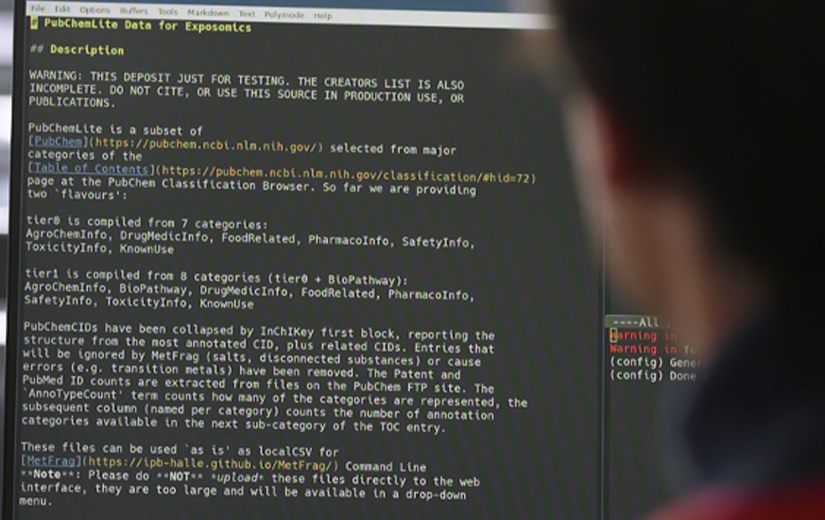The Environmental Cheminformatics group is supported by the Luxembourg National Research Fund (FNR) ATTRACT Programme, the European Union Horizon 2020 and Horizon Europe Research Programmes and the University of Luxembourg Institute for Advanced Studies.



Our research projects
The Environmental Cheminformatics group is leading or involved in several national, European and international research projects:
-
Duration:
2022-2023
-
Funding source:
LCSB
-
Researchers:
Dagny Aurich, Emma Schymanski
-
Partners:
Jamie Perera (JPML)
-
Description:
The story of our chemical past, present and future made into a sonification piece that demonstrates the immense scale of the chemical problem, exemplified with DDT and PFAS, based on the figure created by Dagny Aurich as part of Arp et al (2023) DOI: 10.1021/acs.est.3c01735.
The heartbeat tracks time, the clicking noise represents the growth in chemical numbers (right axis), the chords the patent numbers (stripes), while key events (blue/purple) have their own distinct sound.
-
Project details (PDF):
-
Duration:
2018-2023
-
Funding source:
ATTRACT fellowship from the Luxembourg National Research Fund (FNR)
-
Researchers:
Emma Schymanski, Lorenzo Favilli, Anjana Elapavalore, Todor Kondic (alumni), Adelene Lai (alumni), Randolph Singh (alumni)
-
Partners:
This project involves several internal partners within the LCSB, including the Enzymology and Metabolism group, Systems Ecology group and the Bioinformatics Core, as well as the Cheminformatics and Computational Metabolomics group from FSU Jena.
-
Description:
Started in 2018, ECHIDNA aims to build computational methods suitable for investigating and elucidating unknowns and causes of effects using HRMS of small molecules. Computational and experimental developments will improve structure elucidation, including cheminformatics approaches as well as stable and dynamic labelling of samples. New cheminformatics methods will improve our understanding of the fundamentals of HRMS and work towards the “holy grail” of a full Computer- Assisted Structure Elucidation (CASE) system for HRMS. A microbiome-PD cohort study will yield complex samples with patient/early stage/control information allowing a discovery-based prioritisation of potential neurotoxins amongst these samples. Single cell biological systems will yield additional information on known and unknown metabolites in well-understood systems.
-
Project details (PDF):
-
Duration:
2021-2026
-
Funding source:
EU project funded under the H2020 research and innovation call “Building a low-carbon, climate resilient future: Research and innovation in support of the European Green Deal: Innovative, systemic zero-pollution solutions to protect health, environment and natural resources from persistent and mobile chemicals” (grant 101036756)).
-
Researchers:
Parviel Chirsir, Emma Palm, Emma Schymanski
-
Partners:
The project involves 15 partners and is led by the Norwegian Geotechnical Institute (NGI) with Dr Sarah Hale as the Project Coordinator and Prof. Hans Peter Arp as co-coordinator.
-
Description:
ZeroPM launched in 2021 to interlink and synergise prevention, prioritisation and removal strategies to protect the environment and human health from PM substances. ZeroPM will establish an evidence-based multilevel framework to guide policy, technological and market incentives to minimise use, emissions and pollution of entire groups of PM substances. The Environmental Cheminformatics group is involved in the Substance Grouping work package of ZeroPM, collaborating with Prof. Hans Peter Arp (NGI), work package lead, and Dr Zhanyun Wang (EMPA). The Substance Grouping team will look at ways to prioritise all groups of PM substances and transformation products on the global market for prevention and remediation prioritisation, integrating this information into open resources for maximal dissemination.
-
Project details (PDF):
-
Duration:
continuous
-
Funding source:
The NORMAN-SLE is funded in part by the NORMAN Association and other projects mentioned on this webpage.
-
Researchers:
Hiba Mohammed Taha, Emma Schymanski
-
Partners:
We gratefully acknowledge our many collaborators contributing to these Open Science initiatives, especially the PubChem, CompTox and NORMAN members working closely with us.
-
Description:
Ensuring the open availability of high-quality data is critical to improving computational methods. The Environmental Cheminformatics group is a key contributor to several initiatives within the NORMAN Network and beyond. We will continue to coordinate the NORMAN Suspect List Exchange (NORMAN-SLE), ensuring our datasets are FAIR, archived on Zenodo and integrated into public resources such as PubChem and the CompTox Chemicals Dashboard. The NORMAN-SLE is also available as a Data Source in PubChem, with annotation content added progressively, and as lists in CompTox. Our work with PubChem is part of the ECI R3 workflows on GitLab. The NORMAN-SLE is tightly connected with unique European initiatives launched within several NORMAN working groups (Prioritisation, EDA and Non-target screening) such as NormaNEWS, the NORMAN Digital Sample Freezing Platform and MassBank.EU.
-
Project details (PDF):
-
Duration:
2021-2027
-
Funding source:
PARC is funded under the European Union’s “Horizon Europe” framework programme
-
Researchers:
Anjana Elapavalore (WP7), Hiba Mohammed Taha (WP4,8), Emma Schymanski (WP 4,7,8)
-
Partners:
Coordinated by ANSES, the French Agency for Food, Environmental and Occupational Health & Safety, PARC involves 200 partners in 28 countries and at EU level, national agencies and research organisations working in the areas of the environment or public health, the European Chemical Agency (ECHA), the European Food Safety Authority (EFSA) and the European Environment Agency (EEA).
-
Description:
The European Partnership for the Assessment of Risks from Chemicals (PARC) was launched in May 2022 and seeks to develop next-generation chemical risk assessment in order to protect health and the environment. PARC aims to advance research, share knowledge and improve skills in chemical risk assessment. By doing so, it will help support the European Union’s Chemicals Strategy for Sustainability, paving the way for the “zero pollution” ambition announced in the European Green Deal. The Environmental Cheminformatics group are involved in work packages 4 (Monitoring and Exposure), 7 (FAIR Data) and 8 (Concepts and Toolboxes). Anjana Elapavalore is now a qualified GO FAIR Three-Point FAIRification Framework Facilitator within PARC.
-
Project details (PDF):
-
Duration:
2021-2023
-
Funding source:
Source Control is funded by Le Gouvernement du Grand-Duché de Luxembourg (Eau-2021-015)
-
Researchers:
Parviel Chirsir, Emma Schymanski
-
Partners:
Source Control is coordinated by the Luxembourg Institute of Science and Technology (LIST).
-
Description:
Source Control is a case study on industrial emitters of micropollutants in a waste water treatment plant catchment, including identification of candidate compounds through process-related data mining and non-target analysis.
-
Project details (PDF):
-
Duration:
2018-2024
-
Funding source:
MICROH is supported by the PRIDE doctoral research funding scheme (PRIDE17/11823097) of the Luxembourg National Research Fund (FNR).
-
Researchers:
Begoña Talavera Andujar, Emma Schymanski
-
Partners:
PhD candidates will conduct their research projects either at the LCSB, LSRU, PHYMS-RU, LIH, LNS, IBBL and/or LIST.
-
Description:
MICROH, which stands for “Microbiomes in One Health”, is a competitive, interdisciplinary PhD training programme. MICROH aims to study interactions within and between microbiomes in relation to two major healthcare challenges of our time, i.e. the spread of antimicrobial resistance genes and the increasing prevalence of chronic diseases. MICROH bridges microbiology and big data analytics in a structured doctoral training environment.
By tackling frontier research questions of immediate public health relevance, the research-intensive programme responds to the unmet need of training the next generation of microbiome scientists in an interdisciplinary environment covering integration and analysis of multi-omics data, as well as basic and translational biomedical knowledge, and its practical application to the diagnosis of diseases and ultimately their treatment. The programme includes transferable skills training, support in career development, lectures and teaching by international experts and annual PhD symposia.
-
Project details (PDF):
-
Duration:
2019-2023
-
Funding source:
SinFonia is an EU funded H2020 project
-
Researchers:
Corey Griffith
-
Partners:
SinFonia is conducted in collaboration with the Enzymology and Metabolism group.
-
Description:
SinFonia aims to integrate the non-native element fluorine into the metabolism of Pseudomonas putida to produce novel fluorinated polyhydroxyalkanoates (PHAs), ideally in such a way that bacterial growth will become dependent on this incorporation. Fluorine is common in industrial chemicals with versatile applications from electrical insulation to waterproofing, yet it is seldom present in biological systems. The current production processes for fluorochemicals often negatively affect the environment, and there is a great need for more sustainable and less harmful alternatives. If successful, SinFonia will provide a less hazardous and more sustainable solution to synthesising fluorochemicals.
Our role is to identify fluorinated and undesirable metabolites in engineered bacteria using non-targeted mass spectrometry. Engineered systems may lack sufficient metabolite repair capacity, which we aim to counteract by screening for metabolite damages in our cell factories and envisaging strategies to repair them. Metabolite repair may be particularly important in SinFonia due to the load of adding heterologous pathways and a non-native element to create new-to-nature products.
-
Project details (PDF):
-
Duration:
2020-2023
-
Funding source:
LuxTIME is a pilot project in the University of Luxembourg’s Institute of Advanced Studies (IAS).
-
Researchers:
Dagny Aurich, Emma Schymanski
-
Partners:
LuxTIME fosters the energies and skills across two interdisciplinary centres (LCSB, C2DH) at the university, in cooperation with the Luxembourg Institute of Science and Technology (LIST).
-
Description:
The “Luxemburg Time Machine” (LuxTIME) project will explore radically new ways for analysing and interpreting factual evidence of the past. We intend to build an interdisciplinary framework for investigating “big data” of the past, inspired by the conceptual premises of the “European Time Machine” Flagship project. The LuxTIME digital dataset will include information from three different fields and scientific perspectives (eco-hydrology, medicine and history) and use a local showcase (i.e. the industrialisation of Belval / Minette region) as a testbed to study the impact of environmental changes on the health of the local population in a long term perspective.
LuxTIME will study the past in completely new ways using evidence from eco-hydrological studies (water and pollutant sources, flow paths and transit times, topographic / geological transformations), medical records (describing disease patterns, mortality rates, social/psychological well-being), bio-chemical data (based on mass spectrometry techniques) and history (archival sources documenting economic, social, political and cultural changes. By mixing contextual information based on archival evidence with scientific evidence derived from chemical, biological, or medical investigations, the project explores new ground in interpreting big data of the past in a truly interdisciplinary setting.
The Belval case will critically test the analytical potential of a multi-layered research design which – this is the mid-term ambition – can be expanded into a national case study; that is the building of a real “Luxembourg Time Machine” including many different kinds of data from many different institutions.
-
Project details (PDF):
-
Duration:
continuous
-
Funding source:
Many of these efforts are funded by LCSB as well as the FNR via ECHIDNA and the EU via PARC.
-
Researchers:
Dagny Aurich, Parviel Chirsir, Rick Helmus, Camilla Moruzzi, Begoña Talavera Andujar, Emma Schymanski
-
Partners:
patRoon efforts with Rick Helmus are in partnership with the University of Amsterdam.
-
Description:
Our group develops analytical and computational methods for high throughput non-target high resolution mass spectrometry methods (NT-HR-MS) with a focus on developing open computational methods, primarily using the programming language R. The ECI group are collaborating with Rick Helmus at the University of Amsterdam for the development of patRoon and are actively developing Shinyscreen, which is used in our teaching. MetFrag is being developed in collaboration with the IPB and forms the basis for non-target identification efforts.
-
Project details (PDF):
-
Duration:
continuous
-
Funding source:
MassBank activities performed at LCSB are funded within ECHIDNA and PARC and are in partnership with IPB Halle (Germany) and UFZ (Leipzig, Germany), funded by NFDI4Chem and DeNBI
-
Researchers:
Anjana Elapavalore, Emma Schymanski
-
Partners:
IPB Halle (Germany), UFZ (Leipzig, Germany)
-
Description:
The ECI group continues collaborative activities on the European MassBank server, initiated within the NORMAN Network in 2012. This includes the contribution of high-quality mass spectral data as well as uploading of external contributions and continuing input into server and functional developments.
-
Project details (PDF):
